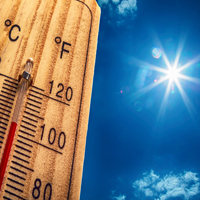Warm Weather Work Safety
July 5, 2018 The Occupational Safety and Health Administration (OSHA) reports that every year, thousands of workers experience illnesses, injuries and even death resulting from cases of occupational heat exposure. Heat exposure is a known work-related hazard (particularly for outdoor workers), which means employers are legally responsible for implementing comprehensive safety programs that address – and guard against – this major health threat.
The Occupational Safety and Health Administration (OSHA) reports that every year, thousands of workers experience illnesses, injuries and even death resulting from cases of occupational heat exposure. Heat exposure is a known work-related hazard (particularly for outdoor workers), which means employers are legally responsible for implementing comprehensive safety programs that address – and guard against – this major health threat.
What is Heat Exposure?
When a person is exposed to warm, humid and/or hot weather conditions, his or her body has to work harder to regulate its internal temperature. Sometimes, the body is unable to cool down by getting rid of excess heat, so instead it stores it: this is considered heat exposure.
Heat exposure can create an array of dangerous and life-threatening medical complications, such as:
- Heat rash;
- Heat cramps;
- Heat exhaustion, and:
- Heat stroke
Consequences of heat stroke, exhaustion, cramps, and rash include difficulty concentrating, red bumps on the skin, dehydration, confusion, nausea, vomiting, involuntary muscle spasms, as well as an increased risk for other kinds of workplace injuries. Any time a heat-related illness or injury is suspected – especially heat stroke, which is typically the most severe – it is critical to call for medical help.
Who is at Risk?
Different types of workers experience heat exposure in certain indoor working environments as well as outdoors, depending on what the conditions are. There are numerous known risk factors for heat exposure, some of which are related to environmental factors while others are job specific (e.g. certain job requirements). Here are some examples of known risk factors from OSHA:
- Physical exertion: workers who physically exert themselves – particularly in certain weather conditions – are more likely to experience heat-related illnesses, injuries, and death;
- High temperature and humidity (risk levels are considered “moderate” for 91°F to 103°F weather, “high” for 103°F to 115°F, and “very high to extreme” when the temperature climbs above 115°F);
- Coming into contact with hot objects;
- Using bulky, non-breathable clothing or personal protective equipment (PPE);
- Direct sun exposure without shady areas;
- Restricted air movement, and:
- Exposure to radiant heat sources
Heat Safety Tips for Employers and Employees
There are numerous steps that employers should take to protect workers from heat exposure. It is also important that if a worker thinks he or she is overheating to report it to a supervisor on duty. Some of the most basic steps that employers and employees can both take to avoid cases of heat exposure resulting in heat cramps, exhaustion, stroke and/or rash include:
- Drink water every fifteen minutes;
- Take breaks in shaded areas to cool down;
- Implement effective engineering controls, which includes adequate ventilation and air conditioning systems;
- Allow workers to build up tolerance by working in the heat little-by-little, and:
- Ensure that employees are trained on the signs and symptoms (as well as prevention tactics) of heat exposure
How to File a Workplace Safety Complaint
Even though the majority of heat-related illnesses, injuries and deaths are preventable, far too many employers fail to prioritize worker health and safety despite knowing just how deadly the consequences can be. Employee reporting can help make a big difference – and it is also anonymous. Many workers may be hesitant to report workplace violations because they fear retribution from their employer, but it is actually illegal for employers to take retaliatory actions.
If you think your job is unsafe or have concerns about heat exposure in the workplace, you can call an OSHA official at 1-800-321-OSHA (6742). If you became ill or injured because of preventable workplace safety violations like heat exposure, please contact a representative at our firm who may be able to help.
Allentown Workers’ Compensation Lawyers at Galfand Berger, LLP Represent Individuals Injured at Work
If you were injured at work, please contact the Allentown Workers’ Compensation lawyers at Galfand Berger. With offices located in Philadelphia, Bethlehem, Lancaster, and Reading, we serve clients throughout Pennsylvania and New Jersey. To schedule a consultation, call us at 800-222-8792 or complete our online contact form.
 Google Screened
Google Screened
